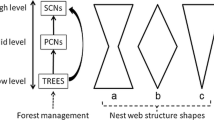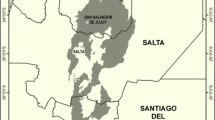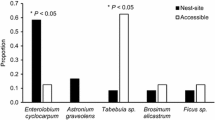Abstract
The Hyrcanian forests of northern Iran support a great diversity of bird species. Yet, the ecological relationships of cavity-nesting birds (CNBs), the main components of forest bird communities in this area, remain unknown. We examined the importance of ecological factors in 90 study plots during the breeding season to predict the probability distribution and habitat suitability of primary cavity nesters (PCNs), secondary cavity nesters (SCNs) and weak primary cavity nesters (WPCNs). Ecological factors included forest structure, habitat complexity, geographical attributes and dead tree features. The significant habitat parameters determining the presence-absence of each CNB species were also determined. PCN richness and abundance were most influenced by the density of larger trees, snags (standing dead trees) and logs (fallen dead trees). The densities of snags, logs and larger trees and the extent of the shrub layer influenced distributions of SCNs. The Eurasian nuthatch (Sitta europaea) was the only WPCN identified, and its distribution was strongly affected by altitude and by larger snags and trees in complex habitats. Our results showed that CNB species could be classified in three groups: (1) species dependent on mature forests, (2) species dependent on younger forests and (3) species adaptable to different forest stages. Overall, snags and logs played vital roles in the habitat preferences of CNB communities as well as in forest structure and complexity.



Similar content being viewed by others
References
Akhani H, Djamali M, Ghorbanalizadeh A, Ramezani E (2010) Plant biodiversity and endemism of Hyrcanian relict forests, N. Iran: a floristic, palaeoecologic and conservation overview. Pak J Bot Spec Issue 42:231–258
Aubry KB, Raley CM (2002) The pileated woodpecker as a keystone habitat modifier in the Pacific Northwest. In: Laudenslayer Jr WF, Shea PJ, Valentine BE, Weatherspoon CP, Lisle TE (eds) Proceedings of the symposium on the ecology and management of dead wood in western forests. USDA Forest Service General Technical Report PSW-GTR-181, pp 257–274
Bahadori Khosroshahi F, AlizadehShabani A, Kaboli M, Karami M, ShariatiNajafabadi M, Ahmadi-Mamaqani Y (2011) A probabilistic model for presence of Eurasian Nuthatch (Sittaeuropaea) in the Alborz mountains, northern Iran. Wilson J Ornitol 123:740–746
Bai M (2005) Tree cavity abundance and nest site selection of cavity nesting birds in a natural boreal forest of West Khentey, Mongolia. Dissertation, Georg-August-Universität
Bonham K, Mesibov R, Bashford R (2002) Diversity and abundance of some ground-dwelling invertebrates in plantation vs. native forests in Tasmania, Australia. For Ecol Manag 158:237–247
Brotons L, Mönkkönen M, Huhta E, Nikula A, Rajasärkkä A (2003) Effects of landscape structure and forest reserve location on old growth forest bird species in Northern Finland. Landsc Ecol 18:377–393
Bull EL, Parks CG, Torgersen TR (1997) Trees and logs important to wildlife in the interior Columbia river basin. USDA For Serv Gen Tech Rep PNW-GTR 391
Bunnell FL, Kremsater LL, Moy A (2014) Coarse filter assessment of contribution of dying and dead wood to sustaining biodiversity on TFL 48 Progress Report
Burnham KP, Anderson DR (2002) Model selection and multimodel inference: a practical information-theoretic approach, 2nd edn. Springer, New York
Diaz L (2006) Influences of forest type and forest structure on bird communities in oak and pine woodlands in Spain. For Ecol Manag 223:54–65
Doherty PF, Grubb TC (2000) Habitat and landscape correlates of presence, density, and species richness of birds wintering in forest fragments in Ohio. Wilson Bull 112:388–394
Etemad V (1994) Estimating of quantity and quality of conclusion forestry project. MSc Thesis, University of Tehran
Etemad V (2002) Quantitative and qualitative investigation of seed production of Oriental Beech (Fagus orientalis lipsky) in Mazandaran forests (Iran). Dissertation, University of Tehran
Fernández-Juricic E (2004) Spatial and temporal analysis of the distribution of forest specialists in an urban-fragmented landscape (Madrid, Spain): implications for local and regional bird conservation. Landsc Urban Plan 69:17–32
Ganey JL (1999) Snag density and composition of snag populations on two national forests in northern Arizona. For Ecol Manag 117:169–178
Ganey JL, Vojta SC (2004) Characteristics of snags containing excavated cavities in northern Arizona mixed-conifer and ponderosa pine forests. For Ecol Manag 199:323–332
Gates JE, Giffen NR (1991) Neotropical migrant birds and edge effects at a forest-stream ecotone. Wilson Bull 103:204–217
Ghadiri Khanaposhtani M, Kaboli M, Karami M, Etemad V, Baniasadi S (2012) Effects of logged and unlogged forest patches on avifaunal diversity. J Environ Manag 51:750–758
Gharehaghaji M, AlizadehShabani A, Feghhi J, Danehkar A, Kaboli M, Ashrafi S (2012) Effects of landscape context on bird species abundance of tree fall gaps in a temperate deciduous forest of Northern Iran. For Ecol Manag 267:182–189
Gillespie TW, Walter H (2001) Distribution of bird species richness at a regional scale in tropical dry forest of Central America. Biogeography 28:651–662
Gil-Tena A, Saura S, Brotons L (2007) Effects of forest composition and structure on bird species richness in a Mediterranean context: implications for forest ecosystem management. For Ecol Manag 242:470–476
Hausner VH, Yoccoz NG, Ims RA (2003) Selecting indicator traits for monitoring land use impacts: birds in northern coastal birch forests. Ecol Appl 13:999–1012
Haveri BA, Carey AB (2000) Forest management strategy, spatial heterogeneity, and winter birds in Washington. Wildl Soc B 28:43–652
Imbeau L, Monkkonen M, Desrochers A (2001) Long-term effects of forestry on birds of the eastern Canadian boreal forests: a comparison with Fennoscandia. Conserv Biol 15:1151–1162
Johnson MD (2007) Measuring habitat quality: a review. Condor 109:489–504
Johnson G, Freedman B (2002) Breeding birds in forestry plantations and natural forest in the vicinity of Fundy National Park, New Brunswick. Can Field Nat 116:475–486
Kaboli M, Guillaumet A, Prodon R (2006) Avifaunal gradients in two arid zones of central Iran in relation to vegetation, climate, topography and altitude. Biogeography 33:133–144
Kaboli M, Aliabadian M, Tohidifar M, Hashemi A, Roselaar CS (2015) Atlas of birds of Iran. Department of Environment of Iran, p 628
Kaiser HF (1960) The application of electronic computers to factor analysis. Educ Psychol Meas 20:141–151
Keller JK, Ritchmond ME, Smith CR (2003) An explanation of patterns of breeding bird species richness and density following clearcutting in northeastern USA forests. For Ecol Manag 174:541–564
Kirk DA, Hobson KA (2001) Bird-habitat relationships in jack pine boreal forests. For Ecol Manag 147:217–243
Laiolo P (2002) Effects of habitat structure, floral composition and diversity on a forest bird community in northwestern Italy. Folia Zool 51:121–128
Laiolo P, Caprio E, Rolando A (2002) Effects of logging and nonnative tree proliferation on the birds overwintering in the upland forests of northwestern Italy. For Ecol Manag 179:441–454
Lammertink M (2004) A multiple-site comparison of woodpecker communities in Bornean lowland and hill forests. Conserv Biol 18:746–757
Laudenslayer WF, Shea PJ, Valentine BE, Weatherspoon CP, Lisle TE (2002) Proceedings of the symposium on the ecology and management of dead wood in Western Forests. USDA For Serv Gen Tech Rep PSW-GTR 181:247–256
Lee PF, Ding TS, Hsu FH, Geng S (2004) Breeding bird species richness in Taiwan: distribution on gradients of elevation, primary productivity and urbanization. Biogeography 31:307–314
Machtans C, Latour P (2003) Boreal forest songbird communities of the liard valley, northest territories, Canada. Condor 105:27–44
Mannan RW (1977) Use of snags by birds, Douglas-fir region, western Oregon. MS thesis, University of Oregon State Corvallis
Martin K, Aitken KEH, Wiebe KL (2004) Nest sites and nest webs for cavity-nesting communities in interior British Columbia, Canada: nest characteristics and niche partitioning. Condor 106:5–19
Marvi Mohajer MR (2005) Silviculture, 2nd edn. University of Tehran, Tehran
Mikusin´ski G, Gromadzki M, Chylarecki P (2001) Woodpeckers as indicators of forest bird diversity. Conserv Biol 15:208–217
Mitchell MS, Lancia RA, Gerwin JA (2001) Using landscape-level data to predict the distribution of birds on a managed forest effect of scale. Ecol Model 11:1692–1708
Nadkarni NM, Longino TJ (1990) Invertebrates in the canopy and ground organic matter in a Neotropical montane forest, Costa Rica. Biotropica 22:286–289
Newton I (1994) The role of nest site in limiting the numbers of hole nesting birds: a review. Biol Conserv 70:265–276
Nilsson SG, Hedin J, Niklasson M (2001) Biodiversity and its assessment in boreal and nemoral forests. Scand J Forest Res 3:10–26
Purcell KL (2002) Abundance and productivity of birds over an elevational gradient. USDA For Serv Gen Tech Rep PSW-GTR 183:121–132
R Core Team (2014) R: a language and environment for statistical computing. R Foundation for Statistical Computing, Vienna, Austria. www.R-project.org
Radford JQ, Bennett AF, Cheers GJ (2005) Landscape-level thresholds of habitat cover for woodland-dependent birds. Biol Conserv 124:317–337
Rhim SJ, Lee WS (2000) The relationships between habitat structure and breeding bird communities in deciduous forest in Mid-eastern Korea, Japan. J Ornithol 49:31–38
Roberge JM, Angelstam P (2006) Indicator species among resident forest birds—a cross-regional evaluation in northern Europe. Biol Conserv 130:134–147
Robinson D, Robinson S (1999) Effects of selective logging on forest bird populations in a fragmented landscape. Conserv Biol 13:58–66
Samuelsson J, Gustafsson L, Ingelög T (1994) Dying and dead trees—a review of their importance for biodiversity. Threatened Species Unit, Swedish University of Agricultural Science, Uppsala
Sarmadian F, Jafari M (2001) The survey of soil of the Kheyroud forest research station university of Tehran, Iran. J Nat Resour 291:33–89
Scott VE (1978) Characteristics of ponderosa pine snags used by cavity nesting birds in Arizona. Forestry 76:26–28
Scott VE, Oldemeyer JL (1983) Cavity-nesting bird requirements and response to snag cutting in ponderosa pine. In: Davis JW, Goodwin GA, Ockenfels RA (technical coordinators) Snag habitat management: proceedings of the symposium, USDA For Serv Gen Tech Rep RM-99, Flagstaff, Arizona
Sekercioglu CH (2006) Increasing awareness of avian ecological function. Trends Ecol Evol 21:464–471
Shankar Raman TR, Joshi NV, Sukumar R (2005) Tropical rainforest bird community structure in relation to altitude, tree species composition and null models in the Western Ghats, India. Bombay Nat Hist Soc J 102:145–157
Sharpe F (1996) The biological significant attributes of forest canopies to small birds. Northwest Sci 70:86–93
Showalter CR (2000) The relationships between snags and cavity-nesting birds in a Gypsy Moth impacted forest. M. Sc. Thesis, West Virginia University
Sillett TS (1994) Foraging ecology of epiphyte-searching insectivorous birds in Costa Rica. Condor 96:863–877
Smith CY, Warkentin IG, Moroni MT (2008) Snag availability for cavity nesters across a chronosquence of post-harvest landscapes in western Newfoundland. For Ecol Manag 256:641–647
SPSS Inc (2007) SPSS 16.0 for windows users guide. SPSS Inc., Chicago, IL
Spiering DJ, Knight RL (2008) Availability of standing trees for large cavity nesting birds in the eastern boreal forest of Quebec, Canada. For Ecol Manag 255:2272–2285
Takekawa JY, Garton EO, Langelier LA (1982) Biological control of forest insect outbreaks: the use of avian predators. Trans N A Wildl Nat Resour Conf 47:393–409
Thioulouse J, Chessel D, Dolédec S, Olivier JM (1997) ADE-4: ecological data analysis: exploratory and euclidean methods in environmental sciences. French National Center for Scientific Research (CNRS), Lyon
Thomas JW, Anderson RG, Maser C, Bull EL (1979) Snags. In: Thomas JW (ed) Wildlife habitats in managed forests: the Blue Mountains of Oregon and Washington. Agriculture Handbook 553, US Department of Agriculture, Forest Service, pp 60–77
Torgersen TR, Bull EL (1995) Down logs as habitat for forest dwelling ants—the primary prey of pileated woodpeckers in northeastern Oregon. Northwest Sci 69:294–303
Tozer DC, Burke DM, Nol E, Elliott KA (2010) Short-term effects of group-selection harvesting on breeding birds in a northern hardwood forest. For Ecol Manag 259:1522–1529
Virkkala R (2006) Why study woodpeckers? The significance of woodpeckers in forest ecosystems. Ann Zool Fenn 43:82–85
Waterhouse FL, Mather MH, Seip D (2003) Distribution and abundance of birds relative to elevation and biogeoclimatic zones in coastal old-growth forest in southern British Columbia. Ecosyst Manag 2:1–13
Wiens J (1992) The ecology of bird communities, vol 1. Cambridge University Press, Cambridge, p 539
Winkel W (1996) The Brunswick research project of the “Vogelwarte Helgoland” on cavity-nesting birds. Vogelwelt 117:269–275
Wübbenhorst J, Südbeck P (2003) Woodpeckers as indicators for sustainable forestry? First results of a study from Lower Saxony. Nationalpark Berchtesgaden Forschungsbericht 48:179–192
Acknowledgments
We thank Mohammad Reza Marvi Mohajer and Abolghasem Khaleghi Zadeh for constructive comments, as well as all those who provided critical reviews of this manuscript, including two anonymous reviewers. We are especially grateful to Dr. Jim Anderson for support and encouragement. Special thanks to Dr. Derek A. Scott who proofread the final text and provided valuable advice and constructive criticism that improved the quality of the manuscript. This study was funded by the department of Research Affairs at the University of Tehran.
Author information
Authors and Affiliations
Corresponding author
About this article
Cite this article
Bani Assadi, S., Kaboli, M., Etemad, V. et al. Habitat selection of cavity-nesting birds in the Hyrcanian deciduous forests of northern Iran. Ecol Res 30, 889–897 (2015). https://doi.org/10.1007/s11284-015-1293-z
Received:
Accepted:
Published:
Issue Date:
DOI: https://doi.org/10.1007/s11284-015-1293-z




